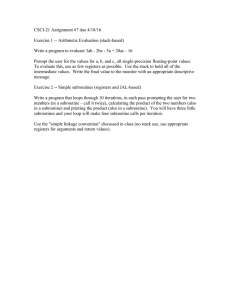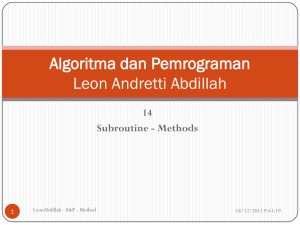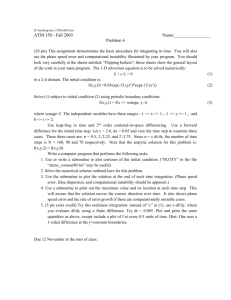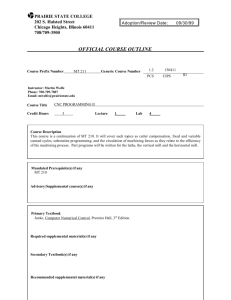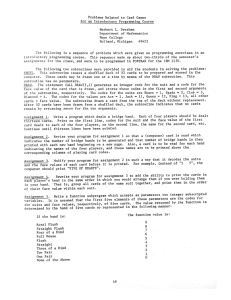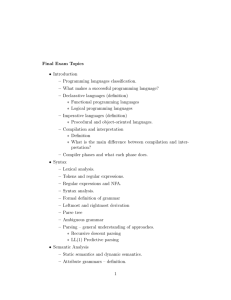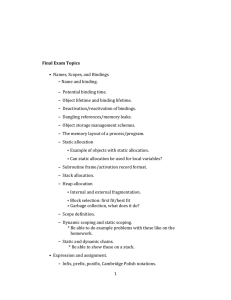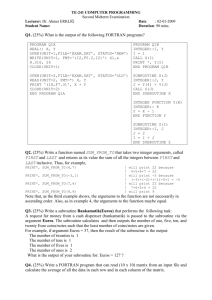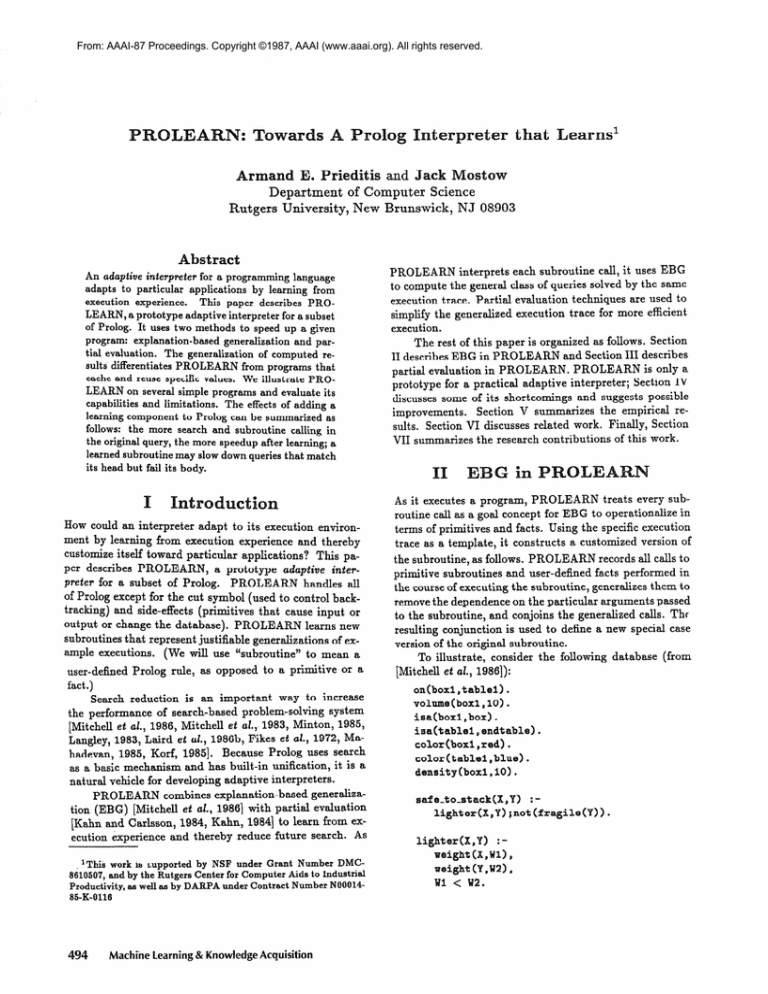
From: AAAI-87 Proceedings. Copyright ©1987, AAAI (www.aaai.org). All rights reserved.
ArEnaand E. P&ditis
and Jack Mostow
Department of Computea: Science
Rutgers University, New Brunswick, NJ 08903
Abstract
PROLEARN
An adaptive inteTpTeter for a programming language
adapts to particular applications by learning from
execution experience. This paper describes PROLEARN, a prototype adaptive interpreter for a subset
of Prolog. It uses two methods to speed up a given
program: explanation-based generalization and partial evaluation. The generalization of computed results differentiates PROLEARN from programs that
cache and reuse specific values. We illustrate PROLEARN on several simple programs and evaluate its
capabilities and limitations. The effects of adding a
learning component to Prolog can be summarized as
follows: the more search and subroutine calling in
the original query, the more speedup after learning; a
learned subroutine may slow down queriesthat match
its head but fail its body.
to compute
execution
simplify
trace.
Partial
techniques
execution
trace for more efficient
The rest of this paper is organized
II describes EBG in PRQLEARN
partial evaluation in PROLEARN.
to its execution
preter for a subset of Prolog.
a prototype
sults.
Section
VII summarizes
environ-
handles
all
except for the cut symbol (used to control backand side-effects
(primitives
that cause input or
output or change the database).
PROLEARN
learns new
subroutines that represent justifiable gener&zations
of example executions.
(We will use “subroutine”
to mean a
user-defined Prolog rule, as opposed to a primitive or a
is an important
way to increase
the performance of search-based problem-solving system
[Mitchell et al., 1986, Mitchell et al., 1983, Minton, 1985,
Langley, 1983, Laird et al., 198623, Fikes et al., 1972, Maha&v=,
1985, Korf, 19851. Because Prolog uses search
as a basic mechanism
and has built-in unification,
it is a
natural vehicle for developing adaptive interpreters.
PROLEARN
combines explanation-based generdiwation (EBC) [Mitchell et al., 19861 with partial evaluation
[Kahn and Carlsson, 1984, Kahn, 19841 to learn from execution experience and thereby reduce future search. As
’TlGs work 1s Lupported by NSF under Grant Number DMC8810507, and by the Rutgers Center for Computer Aids to Industrial
Productivity,as well as by DARPA under Contract Number N6001485-K-0116
Machine Learning 2%Knowledge Acquisitiorn
Section
VI discusses
related
the research
work.
Finally,
contributions
Section
of this work.
in
crdaptive intep-
PROLEARN
as follows.
and Section III describes
PROLEARN
is only a
for a practical adaptive interpreter;
Section IV
some of its shortcomings
and suggests possible
Section V summarizes
the empirical reimprovements.
ment by learning from execution
experience
and thereby
customize itself toward particular apphcations? T&a paper describes PROLEARN,
are used to
prototype
discusses
a program,
PROLEARN
routine call as a goal concept
adapt
call, it uses EBG
evaluation
the generalized
As it executes
How c0l.M an interpreter
fact .)
Search reduction
each subroutine
class of queries solved by the same
execution.
I
of Prolog
tracking)
interprets
the general
terms of primitives
and facts.
trace as a template,
the subroutine,
primitive
subroutines
every sub-
Using the specific
it constructs
as follows.
treats
for EBG to operationalize
a customized
PROLEARN
and user-defined
the course of executing
the subroutine,
remove the dependence
on the particular
to the subroutine, and conjoins
records
facts
version
of
all calls to
performed
generalizes
arguments
the generalized
in
execution
in
them to
passed
calls.
Thr
resulting conjunction
is used to define a new special case
version of the original subroutine.
To illustrate, consider the following database (from
[Mitchell
et al., 19861):
on(boxf ,,tablei).
voluwte(boxl,lO).
isa(boxi Sbox) .
iaa(tablei
oendtable).
color(box1 ,red) .
color (table1
Bblue) .
density(boxl,
i0) S
safe-to-stack(X,Y)
:-
lighter(X,Y);not(fragile(Y)).
lighter(X,Y)
:weight (X,Wl) S
weight (Y ,W2),
Wl < w2.
weight(X,Y) :wollune~x,~~,
density(X,D)
Y iz V * D.
EBG sometimes
D
be simplified
subroutine.
weight(K,50O)
Given
the
:-
isa(X,endtabae).
query
PROLEARN
learns
safe-to-stack(X,Y)
safe-to-staek(boxl,tablel),
the subroutine
:-
produces
a conjunction
by exploiting
This simplification
becomes
below
claus~(wollame(X,v),true),
elause(density&X,B)otsue),
IL4
ie B * D,
evident
solves
from
the Using
The
pole.
formulation
evaluation
the Towers
The program
puzzle-where
the From pole
program
evalua-
of the generalization
example.
of Manoi
of the solution:
the learned
in [Kahn and Carlsson,
in the following
disks are move’d
about
is similar to partial
tion without execution as described
19841 and [Bloch, 19841.
The need for partial
definition
of terms that can
constraints
N 2
to the To pole
uses a standard
0
via
recursive
move N-l disks from the From
pole to the Using pole, move one disk from the From pole
That
product
is, object
of X’s
X is safe to stack
volume
Y is an endtable.
and density
The learned
on object
Y if the
is less than
500 and
uses clause to
subroutine
ensure that user-defined predicates like wolunw, density,
othand iza are evaluated solely by matching stored facts;
erwise the learned subroutine might invoke arbitrarily expensive subroutines for these predicates, thereby defeating
its efficiency. PROLEARN
also learns similar specialized
versions of each subroutine
invoked in the course
cuting safe-to-&a&
(e.g., lighter).
EBG in PROLEARN
tive calls effectively
caches
the result of searching
safe-to-stach(box1
The learned subroutine,
namely
,tablel)
9
isa(obj2 0endtable).
which is unfolded
in terms of prim-
itive calls like iaa(Y ,endtabls),
eliminates this search.
While subroutine unfolding provides some speedup in procedural
languages,
greater be&use-of
While
original
in Prolog
definition,
speedup
can be much
this search reduction.
the learned
trace generated
the
subroutine
is a special
it is a generalization
for the specific
query.
case of the
of the execution
Therefore
it will ap-
ply
- _ to queriesother than the one that led to itscreation,
and should speed up interpret ation for the entire class of
such queries. This class is restricted to queries whose execution would have followed the same execution path as
the original
query.
Relaxing
this restriction
would require
allowing learned subroutines
to call user-defined
subroutines, which would make learned subroutines more general
but possibly less efficient.
PROLEARN
relies on EBG
generalization
is justifiable.
to guarantee that tius
An execution
resulting
to the
BlOV@(O,-,- 9- , Cl).
mower(l,FPo~,To,Using,plan) :N > 0, M is N-1,
Izlovg(PI,From,UP3ing,To,Subplanl),
mover(H,lJeing,To,From,Subplan2),
append(Subplan1, CCFr~~~,T~ll,Frontplan),
app5ndC ClJJ9.
for the
PROLEARN
must determine which definition of weight
to use. As it turns out, the first definition fails and it must
use the second one instead,
plan is bound
The
append(Frontplan,Subplan2,Plan).
intermediate subroutines
needed to answer the query. Par
example, when the query weight (tablei
,W2) is evaluated
in the course of executing
disks from the Using
pole to the To pole.
variable plan.
of exe-
amounts to subroutine
unfoldUnfolding a query into its primi-
ing with generalization.
to the To pole, and finally move N-l
trace constitutes
a proof of a query in the “theory” defined by the subroutines and facts in the program. EBG generalizes away only
those details of the trace ignored by this “proof.99
The
learned subroutine should therefore P ,,rz for any query it
matches, that is, produce the sam1~,oehavior as the original
program. (Section IV discusses the problem of preserving
appsnd(CHIT1 ,L, [HIUI)
:-
append(T,L,U).
Given the query move(3,lsft,right,cgnter,Plan),
Plan is bound
to:
C[left,rightlo i&ft,centerl 9
[right Dcenter]
s Cleft,ri
[centsr,rightl, [left ,ri
Since rsove
LEARN
learns
contains
recursive
three move
learns the following
calls
subroutines.
to stove,
PRO-
In particular
it
subroutine:
mowe(M,From,To,Using,C[From,TolD [From,UsinglB
[To ,Usingl
o CFrom,Tol
DCUsing,Froml
TO] ) [F~oRI,ToI 1)
,
:-
i5 N-l, pI>O, L is M-f,
L>O, 0 is L-l, L>O, 0 is L-l,
M>O, K is M-l, K>O, 0 is K-f,
K>O, 0 is K-I.
The saove definition
learned
by EBG represents
a spe-
cialized subroutine for
to the To pole via th
’
Worse still, future
with move of N > 3 disks will
3 disks from the From pole
pole.
The newly learned
move” z for two disks and one disk are similarly verbose.
queries
match the learned rule and not fail until they reach
conjunct 0 is L-l.
the
The term 0 is K-l (in the above conjunction) could
be eliminated by binding K to 1 instead.
In general, if
two of the unknowns in an expression like X is Y - Z are
known then the third
can be deduced.
PROLEARN
uses
correctness
of the original
program.)
Prieditis and Mostow
4%
such rules to simplify primitive
subroutine
LEARN actually learns the above move as:
calls.
33.
PRO-
move(3,From,To,Using,
C[F~O~,TO]a [Frorn,Usingl,
, [Using ,Frod ,
[To ,Usingl , CF~OIU,TOI
[Using I To] , [From, To] 1) .
PROLEARN
partially
evaluates
the following
between
down
are eliminated
terms like 12 is
X * 4 are eliminated
3. Terms like 4 is
y/3
by binding
kinds of
following
are simplified
((Y > 119, (Y < 1599to exploit PROLEARN’s
division.
Early cutoff occurs
After
partial
PROLEARN
inserts
The
integer
is
that it is tried before
subroutines.
a number
Search
of shortcomings
architectures
common
PaobBem
As
PROLEARN
learns more subroutines,
search time
As an example,
consider member, a
gradually increases.
commonly-used
Prolog subroutine that tests for member-
[Xi-
member(X,
C-IT])
Giventhe
length
[b,c,d,al),
PROLEARN
third
and second
member(X,
member(X,
[TI,T2,XlCTl,XlI).
V-IY,M) .
.
equiw(X
A Y,M A I)
:-
equiv(X,M),
equiv(X
V Y,M V N)
:-
equiv(X,M),equiv(Y,N).
equiv
are equivalent
is used to test whether
boolean
expressions
of 1, A and V).
operators
V b)
equiv(Y,N).
A -(c
V d) s(a
its two
(with
the
Consider
the
V b)
A (c
V d))
(A) to find relevant subroutines.
Here the only match is the
subroutine whose head is equiv(X
A Y ,M A N) . In fact,
there is only one relevant subroutine
at each node of the
entire search tree for this query, so its branching factor is
1. When branching factor is this low, there is no search to
eliminate. Here, speedup derives only from elimination
of
subroutine calls in the learned rules, namely:
A-lY,X
equiw(llX
A Y) .
9.
a query
is worth
cost (search
learning
from
and subroutine
learning, the cost of the learning process,
bution of subsequent queries. PROLEARN
from every execution
without
considering
depends
calling)
on
without
and the distrisimply learns
these factors.
positions
6.
list.
[Tl,TB,T3,Xl-
AlY,M)
equiv(lX
its execution
three member definitions (since zaexnber
three times). They represent member-
mmber(X,
equiv(lX
:-
Whether
xnember(X,T).
ship of an item at the fourth,
in an arbitrary
:-
logical
query:
the
equiv(X,Y).
A Y) ,M)
equiv(llX,X
querymember(a,
learns the following
is called recursively
consider
19851):
equiv(l(X
standard
following
I).
:-
[Mahadevan,
V Y) ,M)
arguments
ship of an item in a list:
member(X,
and remembering?
learning,
equiw(l(X
equiw(ll(a
that learn.
Bottleneck
:-
at the cost of slowing
learning
worthless
(after
beand
Prolog interpreters
typically
index on the subroutine’s
name (equiv)
and the first argument’s
principal functor
Limitations
exhibits
of possibly
database
queries
is worth
The subroutine
subroutine
version from which it was derived,
to other problem-solving
A.
learned
it above existing
V
PROLEARN
the
To ensure
the less efficient original
like
when Y 5 11.
evaluation,
added to the database.
X to
to conjunctions
rth Problem
up some
what
equiv(X,X).
equiw(llX,Y)
X to Y, and
by binding
speeding
others,
As an example
terms: terms like 3 < 5 (that are always true) are eliminated, terms like X == Y (a test on whether X and Y are
the same variable) and X = Y (a test on whether X has the
same value as Y)
The Learning
Given the tradeoffs between storing and computing,
tween the cost of learning and the resulting speedup,
The
Correctness
and
I).
1).
Is the set of programs
new subroutines?
still correct
That
after PROLEARN
is, does the new program
learns
preserve
Given the query mexnber(a, [bpc,d,e,al),
PROLEARN must search through all the learned member defi-
the user-intended
behavior?
Two problems,
redundancy
and over-generalization,
make this question difficult to an-
nitions to get to the general case for member. A query testing the membership
of an object in the list of a hundred
swer.
items may generate ninety-nine
new member definitionsclogging up the interpreter if most of them are executed
to avoid
again.
ular query,
A number
of researchers
have observed
that
uncon-
trolled learning of macro-operators
can cause search bottlenecks [Minton,
1985, Iba, 1985, Fikes et al., 19721.
Minton’s programused
the frequency of use and the heuristic usefulness of macro-operators
as a filter to control learning. Iba’s program learned only those operator sequences
leading from one state with peak heuristic value to another.
4%
Machine Learning & Knowledge Acquisition
PROLEARN
disallows
subroutines
with
side-effects
redundancy.
Since every learned subroutine
in
re p resents another way to execute a particPROLEARN
the database
of original
subroutines
describes how to execute the query (perhaps
cient manner). The danger lies in side-effects
repeated and thus change program behavior
violates the intent of the original program.
PROLEARN
also disallows
already
in a less effithat may be
in a way that
the cut symbol
(used
to
control backtracking
and define negation-as-failure).
If
PROLEARN
allowed the cut symbol, learning new subroutines would, in general, be impossible
without considering
how much
the context of other subroutines
(e.g., cut and fail
combinations that were executed during a particular query).
While applying PROLEARN
to a program with side
effects is not guaranteed to preserve its behavior, neither
does it necessarily
tive interpreters
lead to disaster.
preserve
Demanding
program
behavior
that adap-
penalty,
is unnecessar-
to characterize
and expand
PROLEARN
is also theoretically
subject
ecution
rule that didn’t
apply
this problem
diately
unwieldy
by placing
above
in Prolog)
each learned
the subroutine
from
because
Although
It ap-
problem-solving.
to overcome
member
equiv
2
2
Table 1: Speedup
Table
Factors
While
imme-
1 lists the speedup
original query in Prolog
it was derived
For each example,
1.3
1
6
36
1
1
3
6
factors
the table
time
for the original
follows:
The results
alone,
age branching
greatest
the example
factor
speedup.
from eliminating
The
user subroutine
speedup.
routine
with
above.
with
branching
speedup
averthe
resulted
calls (member and equiv)
arithmetic
1 and few
had the least
resulted
from sub-
not search reduction.
operations
were eliminated.
,
Since each learned subroutine applies to a whole class
of queries, the speedup results apply to the entire class.
However, the results presented above are incomplete,
since
they do not show the slowdown
for queries outside this
class.
Such
slowdown
occurs
when
a query
matches
learned subroutine and then fails after executing
the terms in its definition.
We measured
speedup
does
not
values [Mostow
and
learned
that cache specific
chunks.
et al., 19791, PROLEARN
the execution frequency of different control paths in a program, they do not generalize as PROLEARN
does.
by comparing
time before and after learning.
This paper has shown how an interpreter can adapt to its
execution environment
and thus customize itself to a particular application.
PROLEARN,
a
some of
execution
This comparison
measures
The generalization
sults differentiates
PROLEARN
and reuse specific
values.
The effects of adding
can be summarized
proto-
of computed
from programs
a learning
component
as follows:
The more search
and subroutine
to Prolog -
calls in the original
after learning:
and backtracking
by search are eliminated,
caused
well as the overhead
of subroutine
re-
that cache
query, the more speedup
the indexing
as
calls.
The same speedup applies to the class of queries that
match the learned subroutine, not just the query from
which the subroutine was learned. This class includes
queries that would have followed the same execution
path
as the original
e A learned
Prolog
an implemented
type of an adaptive Prolog interpreter, uses two methods to
increase its performance:
explanation-based
generalization
and partial evaluation.
calls (move).
factor
from EBG
as
a The one example
(move) where partial evaluation
helped was sped up by a factor of 8.5 over EBG because costly
which avoids this
mechanism
subroutines
produced
The next greatest
Any speedup
uses EBG,
chunking
to simplify
occur-
of the same variable,
that are more specific
19841. While some optimizers
use data about the execution environment
[Cohen, 19861 or collect statistics about
over the
the largest
(safe-to-stack)
ca3l elimination,
that multiple
vironments more dynamically
than typical program optimizers [Aho et al., 1986, Kahn and Carlsson, 1984, Bloch,
can be summarized
the user subroutine
two examples
Soar’s
evaluation
cached subroutines
Soar assumes
also lists the average branch-
of calls to user-defined
B For EBG
4
stores genBoth approaches
pay for decreased
execution time with increased space costs and lookup time.
PROLEARN
adapts programs to their execution en-
presented
ing factor and number
query.
exfrom
54 to 156 times slower
PROLEARN’s
PROLEARN
Also,
Cohen, 1985, Lenat
eralized procedures.
Query in Prolog
in CPU
for the examples
ranging
by the interpretation
rences of a constant are instances
which can cause it to learn chunks
than necessary.
Over Original
by factors
is outweighed
resemble Soar’s chunks,
Unlike systems
23
94
4
queries
of Prolog’s
up PROLEARN’s
et a!., 1986b], PROLEARN
is an s’ncbdental learning system because it learns as a side-effect of
use partid
23
11
4
speeds
Like Soar [Laird
assumption.
safe-to-staclt
it loses the efficiency
learning
of the example
The extra
performance
than Prolog.
rather than at the top of the database.
RlOVB
if PROLEARN’s
to the same
subroutine
which
achieved
penalty, which renders PRCLEARN
changing
when the rule was learned.
(though
be
Prolog meta-interpreter.
imposes a considerable
to 32, this speedup
over-generalization
problem as SOAR [Laird et al, 1986a],
in which a learned rule masks a pre-existing
special-case
pears possible
largely
indexing.
the class
of programs PROLEARN
can interpret without
program behavior in unacceptable
ways.
would
simple but inefficient
level of interpretation
ily restrictive,
since not all behavior
changes are unacceptable [Mostow and Cohen, 1985, Cohen, 19861. Further work is needed
speedup
techniques were eficiently
implemented
in the Prolog interpreter itself. PROLEARN
is actually implemented
as a
subroutine
query.
may
slow
down
queries
that
match its head but fail its body.
Prieditis and Mostow
497
[Langley, 19831 P.
Ackmowlledgments
Many
thanks
van, Prasad
go
to
Tony
Tadepalli,
Bonner,
Steve
Smadar
Kedar-Cabelli
Thanks
also go to Chun
Minton,
Sridhar
Tom
for their comments
Mahade-
Fawcett,
and
on this paper.
Liew and Milind
Deshpande
for
their help with I#!.
Langley.
Learning
effective
search
In Proceedings IJCAI-8,
International
heuristics.
Joint Conferences
on Artificial
Intelligence,
Karlsruhe, West
Germany,
[Lenat et al., 19791 D.B. Lenat,
Klahr.
Cognitive
economy
systems.
In Proceedings
Conferences
August
[Aho et al., 1986]
pilerx
A. Aho,
R. Sethi, and J. Ullman. ComTechniques, and TOOL. Addison-
Principles,
Wesley,
Reading,
Mass.,
[Bloch, 19841 6. Bloch.
of Logic Programs.
mann Institute
1986.
S ource-to-Source
Technical
of Science,
Report
Tranaformationa
CS84-22, Weiz-
November
1984.
19861 D. C o h en. Automatic
compilation
of logical
specifications
into efficient programs.
In Proceedings
[Cohen,
American
gence, Seattle, WA,
A AAI-87,
Association
for Artificial
August 1986.
[Fikes et al., 19721 R. Fikes,
P. Hart,
and N. J. Nilsson.
Learning and executing generalized
tificial Intelligence, 3(4):251-288,1972.
ing8 in Artificial
robot plans. ArAlso in Read-
Webber,
Intelligence,
Intelli-
B. L. and Nils-
son, N. J., (Eds.).
[Iba, 19851 G. Iba.
problem-solving.
Learning by discovering
macros in
InternaIn Proceedings IJCAI-9,
tional Joint Conferences on Artificial Intelligence, Los
Angeles,
CA, August
[Kahn, 19841 K. K a h n.
1985.
Partial
methodology
and artificial
5(1):53-57,
Spring 1984.
evaluation,
programming
intelligence.
AI Mugazine,
[Kahn and Carlsson, 19841 K. Kahn
and M. Carlsson.
The compilation
of prolog programs without the use
In Proceedinga of the Internaof a prolog compiler.
tional Conference on Fifth Generation Computer Systems, ICOT, Tokyo, Japan, 1984.
[Kedar-Cabelli
and McCarty,
19871 S. T. Kedar-Cabelli
and L. T. McCarty.
Explanation-based
generalization as resolution
theorem
of the Fourth International
proving.
Machine
In Proceeding8
Learning Work-
ahop, Irvine, CA, June 1987.
[Korf, 19851 R.
Learning to Solve Problem
by
Korf.
Searching for Mucro- Operators. Pitman, Marshfield,
MA,
1985.
[Laird et al., 1986a]
J.E. Laird,
P.S. Rosenbloom,
and A.
Newell. Overgeneralization
during knowledge compilation in soar. In Worbhop
on Knowledge Compilation, Oregon
State University,
Corvallis,
OR, Septem-
ber 1986.
[L&d
et al., 1986b]
Newell.
Soar:
mechanism.
498
J. E. Laird, P. S. Rosenbloom,
and A.
the architecture
of a general learning
Machine Learning, l(l):ll-46,
Machine learning & Knowledge Acquisition
1986.
August
1983.
F. Hayes-Roth,
and P.
in artificial intelligence
IJCAI-6,
on Artificial
International
Intelligence,
Tokyo,
Joint
Japan,
1979.
Verification-based
[Mahadevan, 19851 S. Mahadevan.
a generalization
strategy
for inferring
learning:
In Proceedings
problem-decomposition
methods.
IJCAI-9, International Joint Conferences on Artificial
Intelligence,
Los Angeles,
[Minton, 19851 S. Minton.
for problem-solving.
national
Joint
Los Angeles,
[Mitchell
Conferences
et al., 19861 T.
[Mitchell
view.
Learning
chine Learning,
and Cohen,
tomating
program
R.
Keller,
Palo Alto,
19851 J. Mostow
speedup
and
S.
generalization:
heuristics.
CA,
and
acquirIn Ma-
1983.
and D. Cohen.
by deciding
a
1986.
P. E. Utgoff,
by experimentation:
problem-solving
Tioga,
Intelligence,
Learning, 1(1):47-80,
et al., 19831 T. M. Mitchell,
ing and refining
[Mostow
on Artificial
Mitchell,
Machine
plans
Inter-
IJCAI-9,
1985.
Explanation-based
R. B. Banerji.
1985.
generalizing
In Proceedinga
CA, August
Kedar-Cabelli.
unifying
CA, August
Selectively
Au-
what to cache.
International
Joint ConferIn Proceedinga IJCAI-9,
ences on Artificial Intelligence,
Los Angeles, CA, August 1985.

